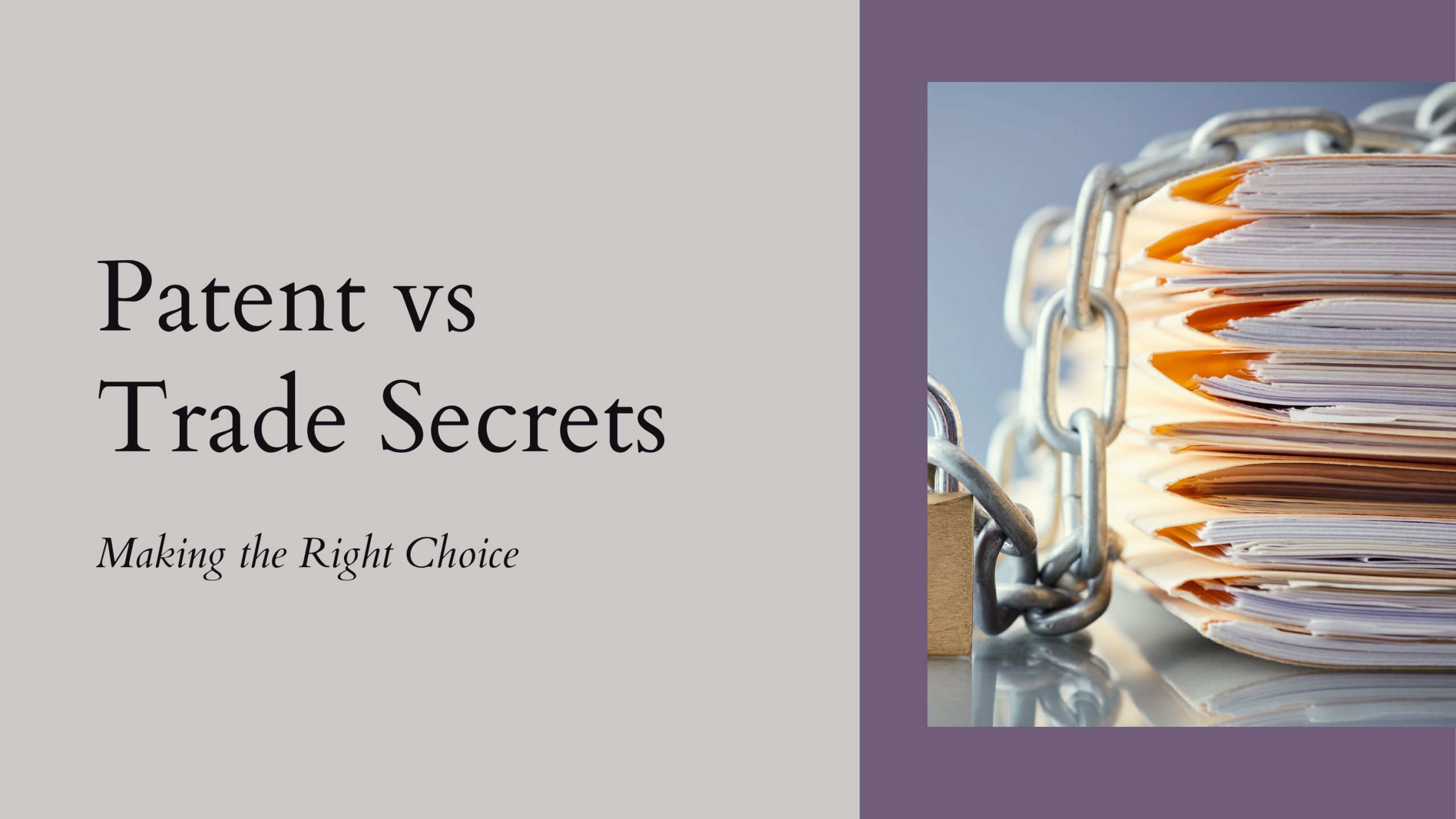In today’s highly competitive business environment, safeguarding intellectual property (IP) is of paramount importance. Two key methods for the same are patents and trade secrets, offering different approaches, advantages, and risks. Organizations must carefully consider to consider these options when protecting their inventions. Patents offer strong legal protection but come with high costs and public disclosure. Trade secrets, while cheaper and without time limits, must be kept confidential. By carefully weighing these options, businesses can safeguard their IP effectively.
Understanding Patents
A patent is a legal protection granted by the government to an inventor, providing the exclusive right to make, use, and sell an invention for a specified period, typically 20 years from the filing date. To qualify for a patent, an invention must be novel, non-obvious, and useful.
Advantages of Patents:
- Exclusive Rights: In India, the patent holder enjoys various privileges, including the rights to exploit, grant licenses, and assign their patents, allowing others to manufacture and sell the patented items. However, these rights are not absolute and are subject to constraints and limitations. Patentees have the right to surrender patents, apply for patents of addition for modifications, and sue for infringement. The TRIPS Agreement, effective from January 1, 1995, ensures comprehensive protection for patent holders globally, prohibiting unauthorized use, making, selling, or importing of patented products and processes. Additionally, patent holders must adhere to specific obligations once their patents are granted.
- Public Disclosure: Public disclosure is essential for inventors to secure their rights before revealing their innovations. Once a patent application is filed, inventors can confidently disclose their invention through trade shows, websites, and other public forums without losing their exclusive rights. Filing a patent establishes a legal claim, preventing others from exploiting the disclosed information. This protection is crucial, as public disclosure could otherwise jeopardize the novelty of the invention and the ability to secure patent rights.
- Increased Market Value: Patents significantly increase a startup’s market value by providing a competitive edge and boosting investor confidence. Research shows that startups with patents achieve higher valuations across all fundraising stages. For example, angel-stage startups with patents had a valuation 93% higher, and late-stage startups saw a 51% increase. This enhanced valuation allows startups to raise more capital while giving up less ownership. Patents signal to investors that a startup has protected its innovations, making it harder for competitors to replicate their products or services. Moreover, the process of obtaining patents reflects a startup’s forward-thinking and professional nature. Therefore, patents not only safeguard intellectual property but also create an innovation ecosystem that enhances the startup’s attractiveness and market value.
- Enhancement of Negotiating Leverage: If your company is negotiating to acquire rights to use another enterprise’s patents through a licensing agreement, having your own patent portfolio can significantly boost your bargaining power. Your patents might be valuable to the other enterprise, allowing you to potentially negotiate a cross-licensing deal. In such an arrangement, both enterprises agree to license their respective patents to each other, creating a mutually beneficial exchange of intellectual property rights.
Disadvantages of Patents:
- Costly and Time-Consuming:
- Applying for a patent is a lengthy and costly process, often taking three to four years. However, market changes or technological advancements could render your invention obsolete before securing the patent. The costs can be substantial, including application fees, patent searches, and attorney fees, regardless of the application’s success. Therefore, the potential profit from the patent should outweigh the investment of time and money. It’s crucial to note that not all patents end up being financially valuable.
- Relatively Short Economic Lifespan:
- One major factor that often deters startups from seeking patents is their relatively short economic lifespan compared to other forms of IP protection. Patents are generally valid for a maximum of twenty years from the filing date. The Economic Survey 2021-22 reports that patent applications typically remain pending for an average of 42 months before a decision is made in India. In some cases, this pending period can significantly shorten the effective lifespan of the granted patent.
- Limited Jurisdictional Protection
- Patents grant exclusive rights within specific jurisdictions, requiring inventors to disclose detailed information about their inventions. However, this protection is limited to the jurisdiction of filing. For example, a patent filed in India does not protect the same technology in other countries unless additional applications are filed there. As a result, inventors often seek patent protection in multiple countries to fully safeguard their innovations.
Understanding Trade Secrets
Trade secrets protect confidential information, including technical and commercial details like distribution methods and client lists, which can be sold or licensed. Unauthorized acquisition, use, or disclosure shall be considered as a violation of trade secret protection. To qualify as a trade secret, the information must be commercially valuable, known to a limited group, and actively kept secret by the owner. Legal protection for trade secrets varies by jurisdiction. In India, trade secret law is primarily governed by common law and equity, with no specific legislation.
Advantages of Trade Secrets:
- Broad scope: Trade secrets can cover virtually any type of confidential information that provides a competitive advantage.
- Indefinite duration: Unlike patents which expire after 20 years, trade secrets can potentially last forever as long as the information remains secret. Famous examples include the Coca-Cola formula , KFC’s recipe and Google’s search algorithm.
- No registration requirements: There are no formal registration requirements to obtain trade secret protection, unlike patents which require a lengthy and expensive application process.
- Covers non-patentable subject matter: Trade secrets can protect valuable information that does not meet the strict patentability criteria, This allows companies to protect a wider range of IP
However, trade secrets do have some key disadvantages compared to patents.
Disadvantages of Trade secrets:
- Trade secrets only provide protection against misappropriation, not independent discovery or reverse engineering. If a competitor independently develops the same or similar information, they are free to use it.
- Trade secret protection is lost forever if the information is publicly disclosed, whereas patents expire after a set term.
- It is more difficult to transfer and license confidential information and to resolve disputes compared to patents.
- Significant and possibly costly efforts are required to preserve secrecy, such as marking documents, limiting information access, and consistently enforcing confidentiality. Patents do not have these administrative burdens.
Conclusion: Choosing the Right Intellectual Property Strategy
In the circumstances when the invention meets patentability requirements, has a limited commercial lifespan, and cannot be easily reverse engineered, a patent is likely the better choice to prevent competitors from legally copying the invention. However, in situations where the invention has a long commercial lifespan, and would be difficult to reproduce, a trade secret may be preferable to avoid the costs and disclosure of a patent.
In certain cases, entities may select to take the approach of Hybrid protection for maximum immunity Many entities use a combination of patents and trade secrets to maximize protection. They can optimize their intellectual property protection strategy. For instance, a company may choose to patent the novel aspects of an invention to establish ownership and prevent competitors from legally replicating it, while keeping certain critical components or processes as trade secrets to maintain a competitive edge beyond the patent term. This hybrid approach allows companies to maximize protection, leverage the benefits of both methods, and adapt to the specific needs of their innovations and business strategies.
Written by Aryan Shetty & Ayushman Kumar, Legal Intern @Intepat IP




